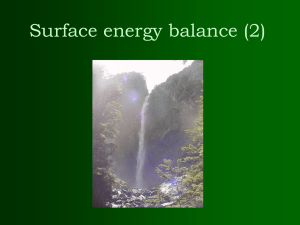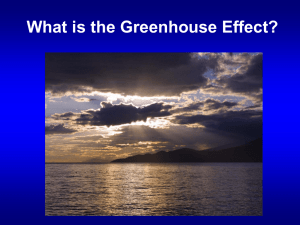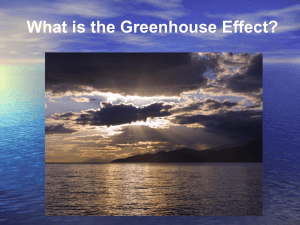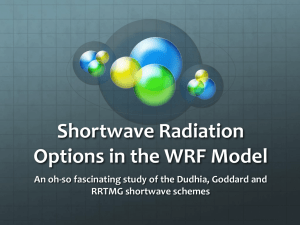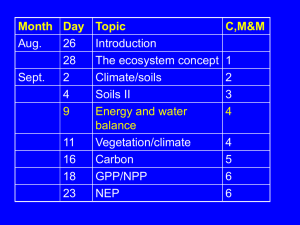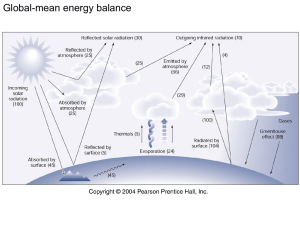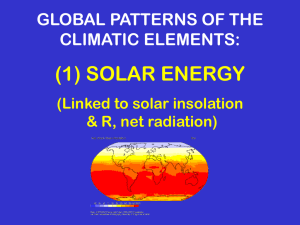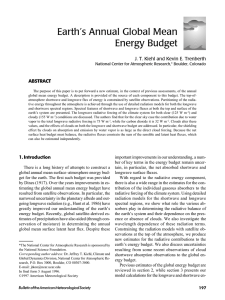Surface energy balance
advertisement
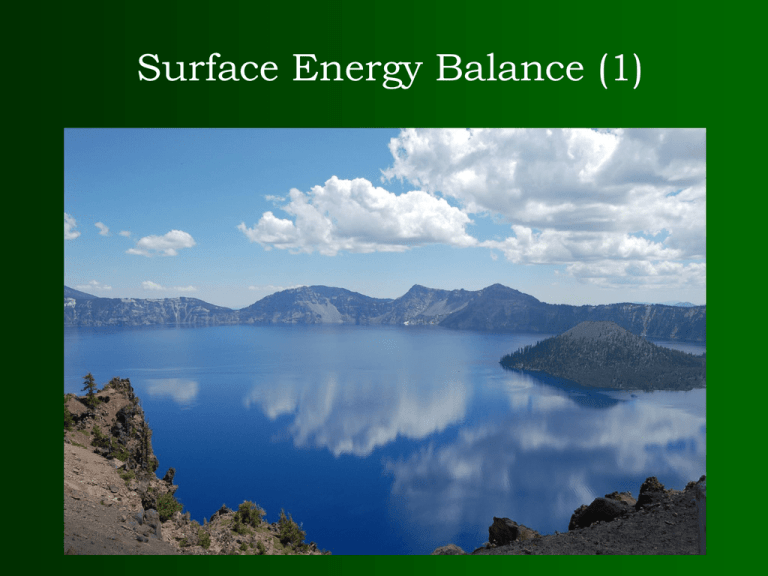
Surface Energy Balance (1) Review of last lecture • The current status of weather and climate predictions: (1) weather prediction good to 10 days, (2) tropical cyclone prediction good in track but not in intensity, (3) climate prediction good to two seasons, (4) climate change projections have a 3-fold difference in magnitude. • The main reasons of the difficulties: (1) Teleconnection problem, (2) Feedback problem, and (3) Subgrid-scale problem. • Importance of the ABL: (1) interface between atmosphere and ocean/land/ice - flux transfer and feedback, (2) the human beings are living in the ABL and change the environment, (3) a basic subgrid-scale process Energy basics • Energy: the ability to do work • Many forms: electrical, mechanical, thermal, chemical, nuclear, … • Joule (J): standard unit of energy (1 J= 0.239 calories) • Watt (W): rate of energy flow (W = 1 J/s) Methods of Energy Transfer • Conduction – Molecule to molecule transfer – Heat flow: warm to cold – e.g. leather seats in a car • Convection – transferred by vertical movement – physical mixing – e.g. boiling water • Radiation – propagated without medium (i.e. vacuum) – solar radiation provides nearly all energy – The rest of this chapter deals with radiation Radiation • Everything continually emits radiation • Transfers energy in waves • Waves are both electrical and magnetic, hence electromagnetic radiation Radiation Quantity and Quality • Quantity: how much? Wave height (Intensity). • Quality: what kind? Wavelength: distance between crest and crest (or trough and trough). generally reported in μm (microns)- one millionth of a meter. The Electromagnetic Spectrum The limitations of the human eye! A man detected by different instruments Infred device Bare eyes X-ray Microscope Wavelength of Sun and Earth Radiation Sun = “shortwave” Sunμm) (0.4-0.7 Peak 0.5 μm (green) Earth = “longwave” (4-100 μm) Peak 10 μm (infrared) Composition of sunlight Physical Representation of Radiation • Blackbodies: purely hypothetical bodies that absorb and emit the maximum radiation at all wavelengths • The Earth and the sun are close to blackbodies. • The atmosphere is not close to blackbody, but it can served as the first order approximation Intensity: Stefan-Boltzmann Law • States that radiation emitted from a blackbody is a function ONLY of temperature • Hotter bodies emit more energy than colder bodies I=T4 where I is the intensity of the radiation, T is the temperature in K, and is the StefanBoltzmann constant, 5.67 x 10-8 W m-2 K-4) • So, double T, 16x more radiation Earth (290K)= 401 Wm-2, Sun (6000K) = • 7.3 x 106 Wm-2. So ISun >> IEarth Wavelength: Wien’s Law • Details the wavelength of peak emission of a body based on its temperature max = 2900 / T where is the wavelength of maximum emission (in m) and T is temperature (K) • Thus, the Earth (290K) = 10 m, and Sun (6000K) = 0.5 m • Wein’s Law tells us that hotter objects radiate at shorter wavelengths than cooler bodies • All bodies emit radiation over a range of wavelengths centered about the maximum predicted from Wein’s Law Satellite Measurements of the Earth’s Radiation Budget NASA’s Earth Radiation Budget Satellite (ERBS) 1985-1989 NASA’s Clouds and the Earth's Radiant Energy System (CERES) on 4 satellites (TRMM, Terra, Aqua, NPP) 2000-now Video: Monitoring Earth's Energy Budget with CERES • http://www.youtube.com/watch?v=D_Qmue54W14 Earth’s energy budget (averaged over the whole globe and over a long time) Yellow: shortwave Red: longwave Sensible heat 7% Net Longwave 21% Latent heat 23% • At the top of the atmosphere: Incoming shortwave = Reflected Shortwave + Emitted longwave • At the surface: Incoming shortwave + Incoming longwave = Reflected shortwave + Emitted longwave + Latent heat flux + Sensible heat flux + Subsurface Diffusion Latitudinal variation of surface net radiation • Tropics – energy surplus • High latitudes – energy deficits • Imbalance of heating between tropics and high latitudes drives global atmospheric circulation (the 3-cell model) Seasonal variation of surface radiation Surface sensible and latent heat fluxes • Both are turbulent (noisy) fluxes related to conduction and convection. • Both proportional to surface wind speed. • Sensible heat flux is dry flux from warm to cold regions • Latent heat flux (also called evaporation) is wet flux from wet to dry regions. Latent heat of evaporation is stored in water vapor and will be released when condensation (clouds/precipitation) happens. Surface Wind From NOAA ESRL Seasonal variation of surface energy budget Storage change = net radiation - latent heat flux sensible heat flux Summary – What is energy? 3 methods of energy transfer – The names of the 6 wavelength categories in the electromagnetic radiation spectrum. The wavelength range of Sun (shortwave) and Earth (longwave) radition – – Intensity of radiation (Stefan-Boltzman law): I=T4 Wavelength of radiation (Wein’s law): max = b/T – Earth’s energy balance at the top of the atmosphere. Incoming shortwave = Reflected Shortwave + Emitted longwave – Earth’s energy balance at the surface. Incoming shortwave + Incoming longwave = Reflected shortwave + Emitted longwave + Latent heat flux + Sensible heat flux + Subsurface conduction
